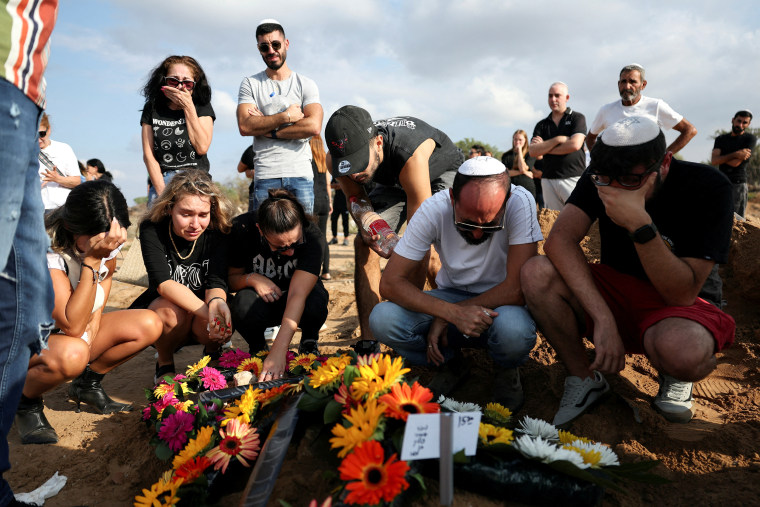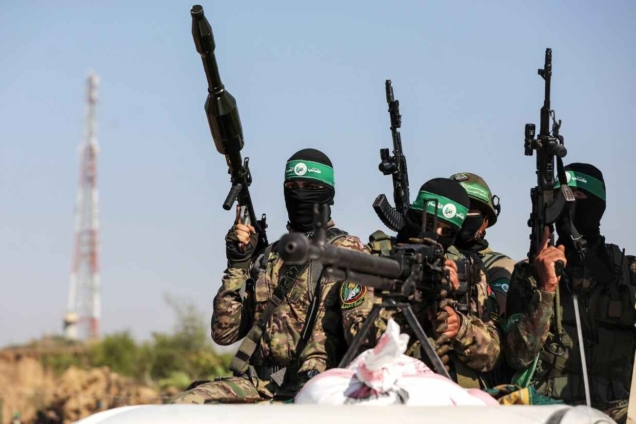American officials are investigating whether some of the Hamas militants who carried out an unprecedented attack on Israel received advanced training from Iran’s Islamic Revolutionary Guard Corps, according to current and former U.S. officials.
They are also examining whether Hamas used recent Palestinian protests along the Gaza border fence as cover to place explosives that were later used to breach the Israeli barrier. The advanced training and placement of explosives, if confirmed, would be the latest example of decades of support that Iran has provided to Hamas.
The attack, which was far more sophisticated than past Hamas operations, would not have been possible without the decades of funding, weapons and training Iran has supplied to the militant group, current and former U.S. officials say.
“Hamas could not be a fraction of the group that it is — neither a political, social or religious entity nor a terrorist and militant entity — without Iran’s financial support, provision of weapons and training,” said Matthew Levitt, a former senior official in the Treasury and State departments who focused on counterterrorism.
At a White House news conference Tuesday, President Joe Biden’s national security adviser, Jake Sullivan, said Iran was “complicit” in the attack, which killed more than 1,000 Israelis. Dozens of Israelis and an unknown number of U.S. citizens were also taken hostage.
“We’ve said since the beginning that Iran is complicit in a broad sense because they have provided the lion’s share of the funding for the military wing of Hamas, they’ve provided training, they have provided capabilities, they have provided support," Sullivan said. "And they’ve had engagement and contact with Hamas over years and years, and all of that has played a role in contributing to what we have seen."
Sullivan added that the U.S. could not confirm at the moment whether Iran knew about the attack in advance or helped plan or direct it.
Levitt said he was skeptical that proof of Iran's direct role in the attack would emerge. He said Iranian officials rarely give explicit orders to their proxies to conduct specific operations. “That’s just not how these things work,” he said.
Iran funnels roughly $100 million a year to Hamas, according to a 2020 State Department report, and it has delivered technology and know-how that have enabled Hamas to build up its own arsenal of rockets in Gaza based on Iranian designs, former officials and analysts said.
In its last conflict with Israel, which lasted 11 days in 2021, Hamas unleashed 4,000 rockets. On Saturday, it fired 2,500 rockets, suggesting it now has an even larger stockpile.

Hamas also used drones to damage cellular transmission stations, limiting communications, and to destroy military surveillance towers, which prevented soldiers from being able to monitor the border, the New York Times reported. Drones also disabled remote-controlled machine guns that were a key tool in thwarting a ground attack.
Hamas focused on swarming multiple entry points on Israel’s border, posting videos of the incursion while waving flags, holding territory for long as possible and killing and abducting Israelis indiscriminately to “puncture Israel’s sense of deterrence and security and then negotiate over hostages and draw them into a land war on your turf,” Levitt said.
For years, Iranian officials have publicly boasted about their role in arming Hamas in Gaza and Hezbollah, an Iranian-backed militia and political party in Lebanon.
In an interview in 2021, Gen. Amir Ali Hajizadeh, the commander of Iran’s Islamic Revolutionary Guard Corps Aerospace Force, said that Gaza and Lebanon were at the forefront of the battle against Israel and that “everything you see of their missile capability has been supported by the Islamic Republic of Iran.”
“Instead of giving them a fish or teaching them to catch a fish," he said, "we taught our allies and friends how to make a hook and they are now in possession of missile capabilities and technologies.”
Iran’s relationship with Hamas dates to the early 1990s, when the group first rose to prominence in Gaza. Iran hosted its leaders at conferences in Tehran in a bid to promote a hard-line alternative to Fatah, the Palestinian party engaging in Arab-Israeli peace talks at the time. Iranian officials invited Hamas militants to training camps set up for Tehran’s proxies in the region.
After it initially provided Hamas with weapons smuggled into Gaza, Iran helped the group manufacture its own rockets locally, based on Iranian designs and technology, according to security experts.
Members of Hezbollah and Iran’s Islamic Revolutionary Guard Corps taught Hamas engineers how to make short-range rockets from everyday materials such as sugar and pipes, said Ido Levy of the Washington Institute for Near East Policy. By 2012, Hamas was firing long-range Iranian Fajr-5 rockets at Tel Aviv and Jerusalem.
Hamas has made steady progress since then in its ability to quickly launch large numbers of rockets and to strike targets up to 45 miles away.
“A lot of what Hamas is firing on Israel is based on Iranian technology, but it’s not necessarily Iranian-manufactured per se,” said Kenneth Katzman, a senior fellow at the Soufan Center, a nonprofit group focusing on global security issues and a former senior analyst with the Congressional Research Service. “Iran was transferring technology to Hamas for a very long time.”
By launching large volleys of rockets, Hamas has tried to overwhelm Israel’s Iron Dome air defense system, which is designed to shoot down low-altitude rockets. Although the Iron Dome system has proven to be largely effective, “some of them inevitably get through,” said Levy of the Washington Institute for Near East Policy.
For decades, Iran has cultivated Hamas, Hezbollah and other proxies across the region, from Lebanon to Yemen, to counter countries with more powerful conventional militaries and to force enemies to think twice before they attack Iran, experts say. In some cases, they have taught different proxies the same strategies and tactics.
Experts said the Hamas assault on Israel bore a striking resemblance to tactics the Hezbollah militia used in Lebanon. It was “straight out of the Hezbollah playbook,” Levitt said.
Latest Stories
-
Budding talent Kwesi Sorotu yet to agree deal with Basel as transfer interest grows
22 minutes -
Guinness Ghana DJ Awards: DJ Khalifa and Emcee Nice wrap up groundbreaking high school tour
28 minutes -
Omane Boamah urges NDC to uphold inclusivity, transparency, and accountability on party’s 33rd anniversary
31 minutes -
Ayew Afriyie urges NPP to publish 2024 election defeat report to foster transparency
37 minutes -
2025 BECE: 21 pregnant candidates, 17 nursing mothers write in Upper East Region
56 minutes -
Avoid examination malpractice – Haruna tells BECE candidates
1 hour -
People insulted my mother for allowing me choose music over medicine – Richie
1 hour -
Highway robbers shoot tipper truck driver in the eye at Gomoa Potsin
1 hour -
It’s selfish to say an artiste should never leave your label – Richie Mensah
1 hour -
Best wishes, be confident and you will succeed – Education Minister to BECE candidates
1 hour -
Examination malpractice is becoming a ritual – Dr. Asah-Asante
1 hour -
Stop the ‘rhetoric’, Ghanaians must enjoy unlimited monthly internet data on fixed fee – MP to Sam George
1 hour -
How South Korea’s CSR efforts in Ghana support Sanitation and the SDGs
2 hours -
Speaker directs MPs, ministers holding office of profit to regularise positions within 14 days
2 hours -
Man remanded for allegedly killing and burying UEW Professor
2 hours

